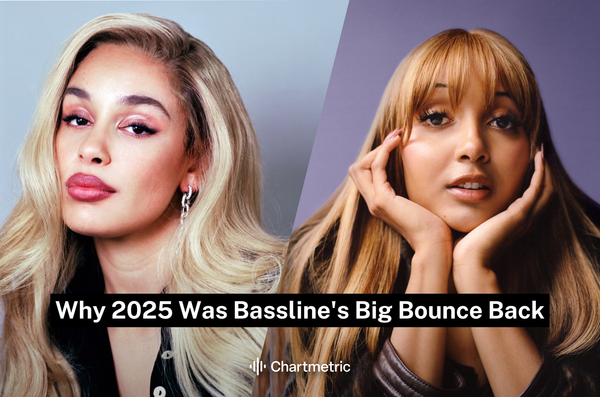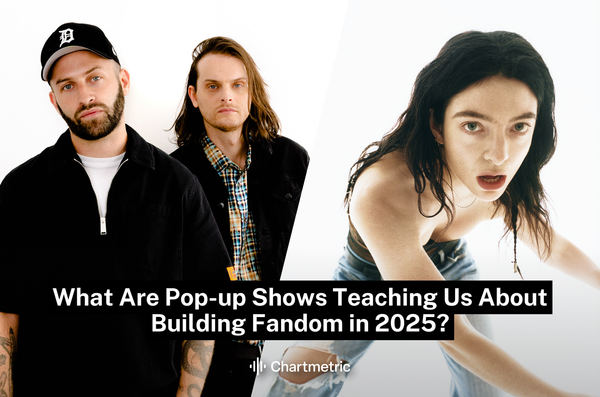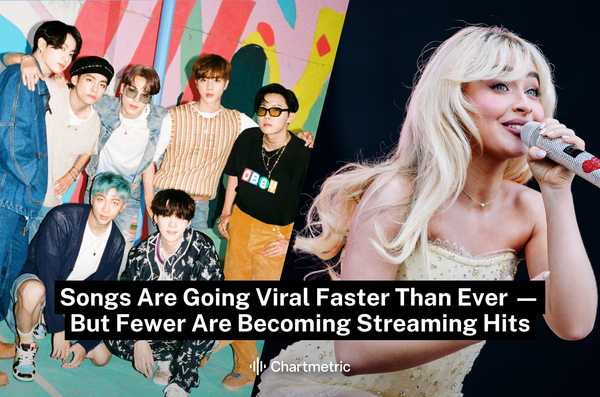This essay was originally published in collaboration with Chartmetric for Stat Significant, a weekly newsletter that features data-driven essays on movies, music, and TV.
The 1990s saw a series of fleeting music fads dominate popular culture. Driven by the growing influence of MTV and the music industry's preoccupation with trend-driven marketing, numerous subgenres emerged, saturated the airwaves, and just as quickly vanished—with these boom and bust cycles playing out over the course of two to three years.
Some prominent short-lived subgenres from the 1990s include:
- The Swing Revival (Peak Years: 1997-1999): Swing revival repopularized big band aesthetics and retro swing sounds, propelled by bands like Cherry Poppin' Daddies ("Zoot Suit Riot"), The Brian Setzer Orchestra ("Jump Jive an' Wail") and Lou Bega's all-time bizarro classic "Mambo No. 5." However, the novelty of this retro fad quickly dissipated, and the music industry moved on within a few years.
- Ska Punk (Peak Years: 1996-1999): Ska punk blended Jamaican ska rhythms with punk rock energy, led by bands like No Doubt, Sublime, Reel Big Fish, and The Mighty Mighty Bosstones. Despite a string of upbeat, radio-friendly hits, the genre fell out of fashion in the early 2000s.
- Nu Metal (Peak Years: 1998- 2003): Nu metal offered a fusion of heavy metal, hip-hop, and alternative rock, led by acts like Limp Bizkit, Korn, Slipknot, and Linkin Park. The genre's aggressive style and angsty lyrics quickly lost mainstream appeal by the mid-2000s as the zeitgeist shifted toward lighter, melodic pop music.
The half-life of popular music is decidedly short. Entire subgenres will hold our collective attention for a few months, while an individual song or artist may achieve mainstream awareness for a few days. Ska punk and swing revival quickly ascended to mainstream prominence only to vanish just as fast—long before Spotify, TikTok, and YouTube accelerated music discovery and consumption. If music stardom was fleeting before the likes of Napster and Pandora, then what does the rapid rise and inevitable fall of a hit song or breakout artist look like in an algorithmically-driven music landscape?
So today, we'll explore how songs and artists trend on the charts, the ephemeral nature of music celebrity, and what this transient fame means for the careers (and lives) of pop stars.
How Long Does It Take for A Song To Reach Peak Popularity (and Subsequently Fade Away)?
Digital platforms like Spotify and TikTok significantly accelerate the viral consumption of new music, spurring intense spikes in popularity. A track is released and disseminated via various algorithms, playlists, and news feeds before listeners move on to the next trending tune. So, in this fast-moving digital landscape, how quickly does a song achieve widespread recognition, plateau on the charts, and fade from popularity?
To better understand the rise and fall of new music, we’ll use Chartmetric's Spotify Top 50 dataset to analyze when a track reaches peak popularity and recedes from mainstream awareness. According to Chartmetric data, nearly 40% of tracks in Spotify's Top 50 peak on the day of their release, while a combined 65% of songs plateau within a week of their debut.
Gone are the days when a song's popularity built slowly through word-of-mouth and radio airplay—replaced by instant surges of premeditated virality.
And how long does a song actually remain in the Spotify Top 50 after securing mainstream listenership? Also not very long (with some exceptions!).
While nearly half of Spotify Top 50 tracks vanish after just one week on the charts, a surprising 20% of trending tunes endure for 90 days or more—evidence that durable hits like "Espresso" and "Hot to Go!" can persist within the zeitgeist for extended periods of time.
Music popularity, as measured by days of mainstream recognition, is growing increasingly brief. A song may sit at the center of popular culture for a week or so before promptly fading away—tossed aside like ska or swing revival. So what does all of this mean for the career and well-being of an aspiring (or current) pop star?
The Ephemeral Agony of Pop Stardom
How long does pop stardom last? By nearly every measure—not very long. Since 2017, roughly 60% of artists who reach Spotify's Top 50 do so with just a single song, and about 80% achieve this milestone with four or fewer tracks.
Most artists score a lone mega-hit that persists for a few days—and that's it—their pop stardom briefer than the life of a monarch butterfly (which, in case you're wondering, isn't very long).
But wait, there's more: artists typically land a Top 50 track early in their careers. Nearly 60% of songs on Spotify's Top 50 are by artists under the age of 31, and almost 90% come from musicians younger than 36.
Taken together, this constellation of data points paints a rather bleak picture:
- Modern pop hits peak within a few days of release.
- Those same songs quickly exit mainstream awareness after a handful of weeks (or less).
- Most artists will achieve this feat once, maybe twice, and then never again.
- Worse still, your brief moment in the limelight will likely come before age 30.
- Plus, this dataset doesn't capture the 99% of aspiring artists that will never make the Spotify Top 50—perhaps a kinder fate than watching a dream materialize, only to vanish days later.
- And yet, for some reason, music stardom is one of the most widely fetishized careers, somehow justifying all this potential suffering.
According to this data, musical fame resembles a Faustian curse: you achieve a lifelong goal for a fleeting moment, then spend the rest of your days trying to recapture this milestone. The stereotype of the tortured artist? Very much a real thing.
Final Thoughts: Consider the Fan
We've discussed how music virality affects an artist's career, but we’ve yet to consider the fan—the person who genuinely connects with these ephemeral hits. What does it mean to thoroughly love an artist or subgenre that briefly captures the cultural spotlight, only to fade into obscurity?
Consider pop punk, which achieved mainstream popularity from the late-1990s until the mid-2000s, with bands like Blink-182, Green Day, Simple Plan, and My Chemical Romance producing several Billboard-charting hits. In 2025, the mainstream viability of this subgenre feels strangely foreign—the angst-filled lyrics, heavy eyeliner, the commercialization of punk rock (a genre never intended for the mainstream), and all the emotional whining that defined these songs. And yet, those who listened to this music in their teen and tween years are condemned to love these songs for eternity, despite later intellectual development.
To someone on the outside of this phenomenon, the notion of wholeheartedly loving Fall Out Boy and My Chemical Romance without any sense of irony or self-awareness may seem alien. For pop punk fans, well, they didn't know any better.
This is the curse of being young and loving music: to embrace something so deeply that is (most likely) an artifact of a fleeting trend.
Ska and swing revival may read like cultural punchlines, but all popular music was taken seriously at some point—and some people will maintain their affinity for these works for the rest of their lives.
If you’d like to read more data-centric essays about movies, music, and TV, check out Stat Significant.






